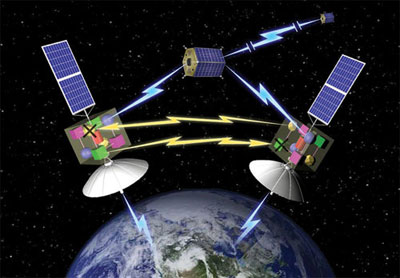Breaking up may be good to doby Jeff Foust
|
| “Half of you are probably thinking, ‘this is the most brilliant thing I’ve ever seen.’ The other half are thinking, ‘this is the dumbest thing I’ve ever heard,’” said DARPA’s Owen Brown. |
A different approach being studied the last couple of years by DARPA as part of its F6 program is to break up, or fractionate, spacecraft (see “From one, many”, The Space Review, August 20, 2007). Rather than a single monolithic spacecraft, several smaller spacecraft, each representing a key subsystem—power, communications, instruments, etc.—would fly together in formation, using wireless data and power links to act as a single spacecraft. Components that malfunctioned or needed to be upgraded could be replaced individually.
“Half of you are probably thinking, ‘this is the most brilliant thing I’ve ever seen.’ The other half are thinking, ‘this is the dumbest thing I’ve ever heard,’” quipped DARPA’s Owen Brown, who chaired a plenary session about the concept at the AIAA Space 2009 conference in Pasadena in September. “I think that’s very symptomatic of a disruptive technology.”
Brown said that the main motivation for this concept is to “answer the call of uncertainty” and develop systems that are flexible and robust, and thus be better prepared to deal with unforeseen developments. Flexibility, he said, gives the networked spacecraft the ability to change missions or respond to component failures, while robustness makes such systems less vulnerable to various threats.
That capability is what gives fractionated spacecraft the edge over existing monolithic ones. “When uncertainty is incorporated into the lifecycle analysis of these types of space systems,” Brown said, “what you will find—and we have found this—is that these systems provide more value at a lower cost than a comparable monolith.”
The long-term vision of such fractionated spacecraft is still several years away from flight testing—an initial test flight is planned for around 2013—but work is underway on the “technology package”, which F6 program manager Paul Eremenko described as “a modular collection of enabling components” that are at the core of the fractionation concept. These systems range from wireless crosslinks to distributed computing to the algorithms needed for flying spacecraft in clusters. The program will also create a “developer’s kit” of open hardware and software specifications to make it easier for new components to integrate into such fractionated systems.
The same technologies can also be used on large spacecraft to create what Eremenko called a “fractionatible monolith”. The technology package can be incorporated on large spacecraft as a hosted payload with a mass penalty of less than 15 kilograms. The payload would remain inactive unless and until a major component on the spacecraft, such as a control processor, failed. A small satellite providing the missing functionality could then be launched and fly in formation with the monolithic spacecraft, with the technology package on the monolith integrating the smallsat’s capabilities into the larger spacecraft.
“What this 20-to-30 pound technology package on the monolith enables us to do is buy architectural assurance,” said Eremenko. This capability is “tremendously enabling, and we get essentially for free” as part of the development of the overall fractionation concept.
The fractionation concept could have benefits well beyond the technology and its applications. Pierre Chao, managing partner with Renaissance Strategic Advisors, said that it could help address issues with the space industry in general. “It is hard to hear, but accurate to say, that in many ways the space industry is a mature industry,” he said. With current systems, he said, we’re hitting the “asymptotic part of the curve” where each incremental advancement is costing an increasing amount of money.
“Usually when you reach this part of the technology curve or the industrial development curve, there is something that comes along that restarts the technology curve and refragments an industry,” he said, suggesting that fractionation could be that technology.
“The intriguing appeal of spacecraft fractionation, and the element that bears a considerable amount of attention to, is the intangibles,” he said. For example, with large, monolithic satellites, there are relatively few programs that engineers can work on, limiting their ability to gain experience. Working on more, and smaller, programs that could be enabled by spacecraft fractionating makes it easier to develop a skilled, experience workforce.
He added that fractionation had other potential benefits. For example, breaking up monolithic spacecraft into smaller components could provide business for developers of new, smaller launch vehicles that would otherwise not be available to them. New companies developing such components would also have an easier time raising money from investors than those seeking to develop far larger and more expensive systems.
| “It is hard to hear, but accurate to say, that in many ways the space industry is a mature industry” and thus ripe for disruptive innovation, Chao said. |
Fractionation could also be essential to what Daniel Hastings, an MIT professor and former chief scientist of the Air Force, says needed for a new space paradigm. Industry today, he said, “has too slow a clock speed” for responding to the needs of users and other changes. “Can you actually come up with space system architectures which are much more responsive and much more flexible?” A new, more flexible architecture, he added, might help entice young engineers to stay in the industry, by giving them short-term projects that provide them a return without waiting for years.
“Things like F6, but also other ways of thinking—on-orbit servicing, operationally responsive space—offer a way to get at these kinds of issues,” he said.
While F6 is a specific program, Brown sees spacecraft fractionating as something much bigger, with implications that go beyond specific technology development. “Fractionation is not a thing,” Brown said. “It is a new paradigm in architecting and acquiring space systems. It will fundamentally revolutionize, we believe, the entire way we buy, build, and operate spacecraft.”
